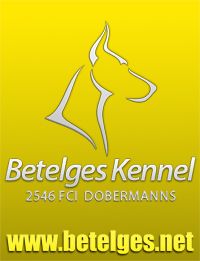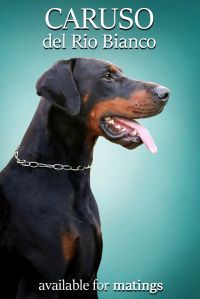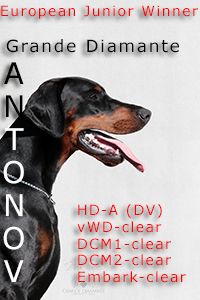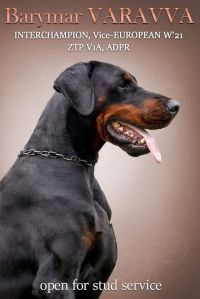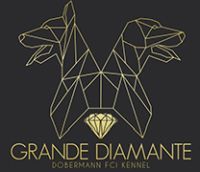When a being dobermann lover isn’t enough
Selection, inbreeding and genetic improvement of the doberman
by Pierluigi Pezzano
Among the several reasons that can induce to choose a pure-bred dog, the possibility to foresee his physical and behavioural characteristics occupies a role of primary importance. The process of taming dogs began about 14000 years ago; in the course of time the man decreed the birth of the various different breeds by fostering the reproduction, and therefore selecting, of those types suitable for some determinate needs: the attitude towards hunting, guard or controlling cattle. This brought to a direct selection of behavioural characteristics and to an indirect selection of some morphological characteristics, such as the shape of the outer ears or the colour of the coat.
At the end of the nineteenth century, the advent of official registers (studbooks) supported the drawing up of morphological standards that however, in many cases, caused the loss of importance of working attitudes.
In Italy, the institution that has the purpose to control the pure bred canine population is the ENCI (Ente Nazionale della Cinofilia Italiana).
Article 2 of the Social Statute states: “The ENCI is a breeders association with economic and technical aspects, aiming at protecting canine breeds by improving and increasing the breeding, as well as regulating and promoting their utilization and value for zoo technical purposes besides sports…” The regulation concerning the constitution of Specialized Societies is described by article 21 of the Social Statute, that also explains its duties: “The board of the ENCI admits as its members with the name of Breed Specialized Associations and gives its own recognition to those Associations that are legally constituted by owners of dogs registered on the genealogical book, who take care for the population genetic improvement, the study, the value of the increment and the employment of a single breed or of a group of similar breeds, entrusting them with research and verification tasks and making agree with them about particular forms of intervention aimed to attain the programs pursued by the Association. The Specialized Associations are also asked to give technical supports to the Central Technical Commission stated by the disciplining guide of the genealogical book…”
In this way, the selection and the genetic improvement of the breed become the essential conditions to realize the mission of Breed Specialized Associations.
The Technical Rules of the Italian Breed help this work of selection and genetic improvement and distinguish between normal reproduction and selected reproduction. So all the parents of the inscribed litters are registered as ordinary or selected sires. As far as the dobermann breed is concerned, a selected sire is the one who is inscribed on the ROI and has the following requisites:
- Ztp attained with qualification 1A or 1B;
- Certificate ENCI 2 or SCHH or IPO organized by AIAD ;
- Exemption form eye diseases stated by a certified veterinarian.
These requisites are also required for those dogs that are imported and inscribed on the Registro del libro genealogico in order to be admitted to selected reproduction. In the event of mate or artificial insemination by a foreign stud, the sons will be inscribed as “be born of selected parents” only if the parents own the same requisites. The sons of selected parents will have a different genealogical certificate with the writing “be born of selected parents”.
The ENCI is a Breeders’ Association and it’s also AIAD, the first one to experiment and to promote selected reproduction in Italy, so it has to accelerate its processes to keep in the vanguard.
Till now the most important step, rightly considered the foundation of the progress in genetic improvement, is the registration of dogs’ performance and certain identification. In our field, the choice of sires to be selected has been based on the concept that animals with the best phenotype look have also the best genotype. The accuracy of this assessment has been gradually improved by comparing and choosing dogs with a genetic likeness superior to the medium of the population (Social Championship, evaluation of performances, statistical-probabilistic evaluation of the genetic quality (worth) of sires according to offspring tests resulting from Ztp data and stored by WinBreed, evaluation of the pedigree, correct determination of the inbreeding read on seven or ten generations).
However I believe that, today, we cannot put aside from a more accurate registration of performances not even from a correct consideration for some phenotypic characteristics of our dobermanns, based on precise and tested models of linear measurement. Obviously these evaluations are out of range of medium breeders but of more structured organizations (specialised centres) able to store and use the data.
In this view the selection program will allow us to choose the best sires (top) and to reject the worst ones, with the purpose of trying to improve the frequency of favourable genes.
This can be realized by selecting the ones with the highest phenotypic qualities, in the belief that their best qualities can be passed on to their sons, obtaining, at last, the sought for improvement.
The policy of the Specialized Association has to concentrate on selecting healthy types, always referring to the population belonging to the breed and to the characteristics of the breed described on the official standard. The genetic improvement of an animal population is pursued by selection that is the choice of the next generation sires.
Nowadays we know that the selection from species to species and from species to breed passes because of a loss of genes and of an increase of the homozygosis; this is the reason why a mating between two dogs cannot produce a cat and a mating between two dobermanns cannot produce a greyhound (even if sometimes something looking like comes out…).
So we must consider that, since a great part of the original genetic heritage has been lost in the characterisation of the species and another great part to define the breed, since the process of selection substantially implies an homozygosis increment – not only because of inbreeding –, a modern dog’s genes are for the most in homozygosis. Now we need to know that only a little fraction of genes allows the breeder to carry out selection and genetic improvement and to give his own imprint on dobermann’s modern breed. So when we talk about inbreeding, or factor of inbreeding (F), and we measure it, we must bear in mind that that measure is referred to a little part of our dobermann’s’ genetic heritage. We must also make it clear that the factor of inbreeding (F) cannot be considered as a direct consequence of the homozygosis because the two alleles passed on by different ancestors could have already been functionally identical.
In order to avoid any misunderstandings about the word inbreeding, I want to clarify that, since it is the result of mating in the same family, it is part of mating systems and that even if it’s very useful the calculus of inbreeding (F), this last is not, as someone says, “a method for selection” and it’s useless at the genetic evaluation of sires, that is carried out according to proper scientific methods. It is a step in the process of selection.
Therefore, we can state that the word “inbreeding” I used in association with three different meanings, that’s to say:
- inbreeding of the individual (or of a population), it’s an index of the individual’s homozygosis (or of the population) that can be measured by proper methods using the inbreeding coefficient (or inbreeding) (F) and that goes from 0 … to 1.
- inbreeding as a mating system, used both as a regular mating system between individuals with known family relationship, and in the practice of linebreeding (mating inside the line). It’s one of the instruments for genetic improvement and gives more or less advantageous results. In this way inbreeding can be considered a filter whose efficacy, in the immediate or in the course of time, depends on the accuracy and on the specific knowledge of the one who determines its intensity and way.
- inbreeding between two individuals, used as a measure of their family relationship, since it’s referred to a specific coefficient of inbreeding called Falconer, different form the one described on point 1) and with which it must not be confused.
We’d better avoid this term (and use “family relationship) in order to keep misunderstandings away.
Nowadays we know that inbreeding, in itself, hasn’t any particular negative or positive action since, with (o by?) genes homozygosis, it brings to a progressive purification of the genetic inheritance owned by the family or the line founders.
As I have already said, in the genetic improvement of dobermann the process of selection is oriented towards the choice of animals with the highest genetic reproduction factors (additive genetic factors); it employs the existing differences in reproduction factors between the various dogs examined for ancestry or blood line.
There are three steps in the selection process:
- the measure and the registration of the characteristics
- the genetic evaluation of the sires
- the choice of the sires
A selection program can be arranged as following:
- set the objectives of selection: the morphological and behavioural characteristics that must be improved;
- organize the selection outlines: the way of meeting the objectives;
- consider the availability and the effectiveness of the instruments of selection;
- verify the course of selection programs
The selection is easier when it’s a single character to be selected (for instance: withers height) but, on the other hand, the breeding of pure-bred dogs needs to select more characteristics that involve both the type’s morphology and his attitudinal and behavioural aspects. So it’s very important to define the characteristics why to select and even to determine the right way to achieve the fixed objectives.
After having studied and verified the objectives of the selection, we need to plan the strategy in order to achieve them.
This is the selection outline: to define which will be the sires of the future generation.
From a genetic point of view, the selection should aim at moving the average of the population and not only at producing just some outstanding elements.
In fact, the outstanding elements grow out of a very selected reproduction and such they are only if they are able to show signs of genetic improvement in their sons on average compared with the relative population.
Always keeping in mind that everyone passes on to his sons a half of his own genes and that, because of the additive effects of genes, they represent the ability or capability of the single one to transmit (Transmitting Ability) or ETA (Estimating Transmitting Ability) that is equal to the half of his reproductive factor.
The concept of selection is strictly connected with that one of intensity of selection, that’s to say the index that shows how much the choice of sires is limited; in fact, if we decide to consider as sires the best 20% of the population it’s intuitive to expect, among them, a greater progress rather than having considered the best 60% of the population.
Anyway we must pay attention to some dangerous genetic bottle-necks that can cause the loss of characteristics and the genetic impoverishment of the breed (high inbreeding).
Therefore, after having set the objectives and the programs of selection and made the necessary instruments available, we need to check the effectiveness of these programs and the results that have been produced by them. All that to make us sure that we are going in the right direction and at which speed.
In order to be able to apply a selection program we need a source of specific information on the population we are interested in. A wide knowledge of the breed and the different morphological and behavioural characteristics we want to select provides a solid foundation for any plan of selection. Even the genetic correlations of the different characteristics with the possibility to inherit them must be carefully studied.
In every program of selection, the physiological determining factors are: possible inheritance, variability and genetic correlation.
The basis of the objectives of selection can be summed up in a few words: health, attitude to work, behaviour, type – morphology, well-being.
The objectives of selection can concern the rapidity of learning, the elimination of a genetic pathology or the improvement of some somatic characteristics.
In sum, we must decide which characteristics we want to keep and which ones we want to give prominence in the new generations.
The way in which characteristics are passed determines how easily we can achieve our objectives of selection. The answer to selection can be quick with qualitative characteristics coded for by a single gene, such as the colour of the coat, or it can require many generations, for instance in case of quantitative characteristics coded for by several genes and depending in proportion to the environment (for instance HD).
The aim of breeding determined by the objectives of selection must be always directed towards the interest of the whole population rather that of a few elements. Health is the first objective among those above; the importance of selecting healthy types has to consider the come up of problems connected with a tendency to exaggerate the morphological characteristics described by the breed standard (hypertype).
While planning the eradication of genetic pathologies, we should pay a particular attention to those genetic pathologies that cause death to those suffering from, or that cannot be controlled. One of the primary aims is to reduce the number of puppies affected by pathology since their birth. The availability of tests to identify precociously those dogs affected by pathology and carriers can make the management of the genetic pathology easier, even if it’s very important to know always their accuracy.
An important basic concept is that mutations and genetic disorders are strictly bound to life and will be always present to various degrees. All living organisms, plants or animals, are characterized by a high number of genes that contribute to life and help the adaptation and the survival of species, but also by a number of negative and even lethal genes.
To obtain the phenotype uniformity we employ inbreeding selection, that’s to say a mating between animals in blood relationship. The result of this method can be very negative when applied to closed population without the right preparation and the right criteria (dog breeds with closed registers). We can have, in fact, a loss of genetic material and of genetic variability useful for studying selection plans. The danger is that there is a high probability that negative genes can be passed on from parents because of reduction of genetic variability.
The trend is that in a particular breed the number of disorders decreases while the frequency increases; it also maybe that the genetic disorder and its degree become, more or less peculiar of the breed itself. Since the approach to the problem depends on the breed that is being considered, it’s evident the centrality of the Specialized Society about the study and the formulation of breeding plans. A selection limited to few characters can bring to a negative reduction of the genetic resources of the breed.
The deleterious effects of inbreeding are known all over the world and can be shortly summarized as the increasing of the frequency of all the genetic defects and the abnormalities due to recessive genes and as the increasing of the inbreeding depression of quantitative characteristics, in particular of those connected with adaptability (reproduction sphere, illness endurance, longevity…).
For all practical purposes, here are the levels considered dangerous for the coefficient of inbreeding of breeding animals by some famous experts. According to the results of some experiments by different researchers on various animal species, in which inbreeding (relationship by birth in the same family) had been induced with a different intensity and for several generations, it was realized that the deleterious effects began to appear at the value of Fa=0,375 (Van Vleck et Al., 1987). Those experts affirm that lower values than this are not to be considered dangerous.
A value like 37,5% of inbreeding can be reached also in two generations of mating between close brothers. This is why, to prevent the deleterious effects of inbreeding, it would be better to avoid mating between close relatives, in this case, between close brothers and parent – son. According to Robinson (1990), on the contrary, values lower than 0,5 are not be considered dangerous.
In this regard we have to pay attention to what Bell (1993) said about the need to go on to the measure of the coefficient of inbreeding beyond the 5th generation (till the tenth, at least) because of the so called background inbreeding, that is the quota of inbreeding that accumulates in these generations.
The phenotype controls have a key role in the valuation of selection objectives and must cover these areas: morphology, behavioural characteristics and attitude to work.
Morphology and Type
The dobermann standard of the breed deals with the ideal characteristics an element belonging to a certain breed should have (type); it’s up to breeders to produce dogs as much as possible similar to this ideal type. One of the main objectives of clubs in breed selection is the pursuit of the correct type. The aim is not only to keep the breed but also to improve it; there’s nothing wrong in trying to improve the morphological characteristics of a breed but this process requires the necessary precautions.
A trend to exaggerate the morphological characteristics (hypertype) can be negative not only for the single one who is in that condition but for the whole breed if considered in its genetic meaning.
First of all we must avoid the hypertype in those characteristics that can influence the physiology of the animal: the search for exaggerate characteristics, especially in particular breeds, can bring to the limits that secure health and well being and sometimes these limits have also been got over (for instance: breeds that usually make use of artificial insemination or Caesarean operation, breeds with plenty and shaggy coat which seriously reduces movements or limits the sight, breeds with a particular shape of the muzzle that hinders breathing).
Also the limitation of breeding to a few blood-lines in order to get a particular type can be dangerous for the same breed when the fixation of morphological characteristics is obtained by a thoughtless use of inbreeding.
Behavioural characteristics
The selection process in canine breeds has taken to set some peculiar behavioural factors that, together with the typical morphological characteristics, differentiate the domestic dog in the various breeds. As far as the typical characteristics of a breed are concerned, the behavioural characteristics aren’t less important than morphological ones and both them must be considered essential for plans of selection.
The correct and careful analysis of the typical behavioural characteristics can help to contain some unpleasant behavioural deviations such as those nasty accidents we often read on the newspapers.
The objectives of selection that are developed in behaviour field must absolutely be based on a careful study of the behavioural schemes we want to select in order to evaluate the possibility a particular characteristic can be passed on, the differences in the various breeds because of a determined aspect (an accurate assessment of the subject requires a specific understanding of the breed), the relationship between different behavioural characteristics. There are not very extensive researches carried out into this argument and it’s important to underline the close connection between hereditary characters and their referential population.
Attitude to work
In the course of domestication process, humans realized that they could use the dog for working: he could help him on hunting, on guarding a house or a land or he could defend him or control sheep. The selection process for these different works took to differentiate the population of Canis familiaris in various groups.
The attitudes towards a specific work led to mate those subjects who behaved in a particular way; the result was the selection of some subpopulations characterized by a particular way of working, who could get the maximum of some behaviours and could limit the expression of some others.
The differentiation of the population according to the various attitudes to work led to a primary subdivision into “breeds”. This first classification provided the genetic material for the modern selection of canine breeds. We can so assert that modern breeds come from primitive work dogs.
The aim of selecting attitudes to work has been, for a long time, the crucial factor in breeding together with the search for an harmonious whole; nevertheless, this lost its importance when selection developed only morphological characteristics, limiting the possibility that the peculiar attitudes owned by many breeds could be passed on.
The use of dogs in work shows gives us the possibility to value them for their attitudinal characteristics; in order to that, it’s impossible to recognize the best ones without a sports comparison of the working characteristics. The attitudes to work of the different breeds are often in second place since they are less easily perceptible rather than the animal’s conformation that is quickly noticeable even to no experts. In some breeds, this dichotomy brought to select work lines and beauty lines. In dobermann breed the phenotype controls consider both attitudinal and behavioural aspects and morphological ones: this makes selection be more accurate and complete.
Well being
The evaluation of well being is connected to the way of breeding, that’s to say how the dogs are kept and where they live. Some kennel clubs regularly visit recognized breeding in order to check animals’ well being. Besides the concept of housing and management, we have also to consider the frequency of mating.
The specialized association and breeders are responsible for giving directions in breeding and for suggesting the purposes to be achieved by selection. The efficacy of the measures that are taken in favour of the protected breed is as greater as higher is the number of breeders who share the initiatives of the club.
The phenotype controls must be intended as something only concerning the dog in question but as powerful instruments for evaluating the state of the breed on the whole.
Breed protection means study and genetic improvement of a population characterized by particular morphological features and behaviours. The evolution of the genetic research and the experience gained whilst selecting other animals of zootechnical interest leads to select sires according to the genotype and not only to the phenotype. The availability of genetic tests to control some pathologies is very important, even if still limited; as far as other diseases are concerned, the selection must be based on phenotype evaluations both of the considered animal and of his parents.
Selection is the most important way by which specialized association and breeders can influence the genetic order of the breed. Its effect depends on the intensity of selection that has been applied in favour of or in order to remove a particular characteristic and, nevertheless, the genetic nature of the line in question; the index of possibility to inherit some characteristics is very important.
In fact the selection for those characteristics determined by more genes on which it’s possible to obtain an environmental effect (quantitative characteristics) depends not only on the choice of sires but most of all on the possibility to inherit the selected characteristic. If the intensity of selection or the possibility to inherit are low, so the progress will be extremely small.
It’s very important to give directions in breeding since the choice to mate some particular dogs and make them reproduce, excluding the others, subdivides the population into two groups according to the frequency of genes.
The sires should have a better genetic combination in relation to those qualities we want to select than the ones that have been considered not good for reproduction. The level of success in selection will depend directly on the ability to choose the group of sires, that’s to say how much the characteristics of the breed are known and rightly valued to make the best choice (phenotype and genotype controls).
The evaluation of the characteristics of the type, attitude and character, can be considered the performance tests for the canine species. They allow us to evaluate a dog for his morphological characteristics and attitudes. The level of functionality of phenotype controls depends on two factors: the accuracy of the evaluation and the possibility to inherit the considered characteristic.
The evaluation of the characteristics capable of being passed is still limited about dogs, but some studies about other species confirm that traits that involve weight, height and type can be easily transmitted while reproductive characteristics are less inheritable. Behaviour and attitudes can be more or less inheritable according to the characteristic in question.
We talk about progeny test when the choice of sires is based on the results of the offspring rather than of the same sire.
The correct evaluation by progeny test must be done, for instance, by mating the sire we want to evaluate with a group of bitches of various level who have been chosen at random; then we have to examine a high number of his offspring grown in environments as much as possible different. Only in this way we can have a correct evaluation of the considered sire.
Pierluigi Pezzano
Bibliography
- Robero Lotta : Elementi di Genetica del cane Edizioni Università di Pisa ottobre 2005
- Roberto Lotta: Elementi di miglioramento genetico in cinologia. Edizioni Università di Pisa
- Norme Tecniche Libro Genealogico Del Cane Di Razza D M 21203 – 8 marzo 2005
- AA.VV. 2001, Central Breeding Policy of the Dutch Kennel Club (DKC).pp 1-17.
- Bell, J.S., 1999. Developing a healthy breeding program. 1999 AKC National Parent Club Canine Health Conference.
- Oberbauer, A.M., Sampson, J., 2001. Pedigree Analysis, Genotype Testing and Genetic Counselling, in The genetic of the dog, Ruvinsky, A & Sampson, J ed.. CABI Publishing, Wallingford, Oxon, UK. pp 461-485.
- Rozzi, P., 1993. Introduzione alla Selezione, in Quaderni Frisona, Associazione Nazionale allevatori di Razza Frisona. Cremona. Italia.
- Svartberg, K., Forkman, B., 2002. Personality traits in the domestic dog (Canis familiaris); Applied Animal Behaviour Science, 79, 133-155.
- Willis, M.B., 1995. Genetic aspect of dog behaviour with particular reference to working ability, in The domestic dog its evolution, behaviour and interaction with people.Edited by James Serpell. Cambridge University Press, Cambridge, UK. pp. 51-64.
- Willis, M.B., 1989. Genetics of the dog. Howell Book House, New York, U.S.A. pp 63-101.














